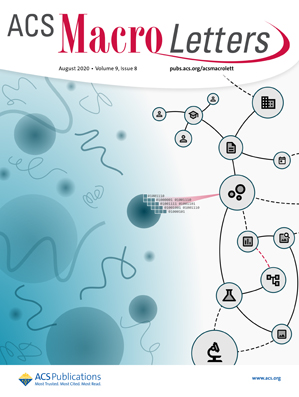Non-Newtonian Behavior of Spherical Coacervate Micelle Dispersions in Aqueous Media.
IF 5.2
Q1 POLYMER SCIENCE
引用次数: 0
Abstract
Non-Newtonian viscoelastic behavior of disordered spherical micelle dispersions composed of complex coacervate core micelles (C3Ms) in aqueous media is investigated by combining rotational rheometry and microfluidic particle focusing measurements. C3Ms were prepared by mixing oppositely charged block copolymers, resulting in spherical micelles with electrostatically neutral coacervate cores surrounded by hydrophilic coronas. Despite the spherical morphology and dispersion in low-viscosity solvents, lateral migration of micrometer-sized particles in microfluidic flow revealed measurable elasticity. The relaxation time (λ), quantified from particle focusing behavior, increased with micelle concentration and scaled with the short-time Brownian diffusion time scale. This suggests that viscoelasticity in C3M solutions originates from diffusive colloidal dynamics consistent with hard-sphere-like interactions. Upon salt addition, micelle dimension and λ decreased significantly, while solution viscosity remained nearly constant. These results demonstrate that λ can be a quantitative indicator of capturing micellar structural changes under external stimuli. This study highlights the use of centerline particle migration as a sensitive probe for weak viscoelasticity in micellar systems and establishes a quantitative link between micellar structure and relaxation dynamics.水介质中球形凝聚胶束分散体的非牛顿行为。
采用旋转流变学和微流控粒子聚焦测量相结合的方法,研究了由复杂凝聚核心胶束(C3Ms)组成的无序球形胶束分散体在水介质中的非牛顿粘弹性行为。C3Ms是通过混合带相反电荷的嵌段共聚物制备的,得到具有静电中性凝聚核的球形胶束,胶束周围有亲水性电晕。尽管在低粘度溶剂中呈球形形态和分散,但微米级颗粒在微流体中的横向迁移显示出可测量的弹性。由粒子聚焦行为量化的弛豫时间(λ)随胶束浓度的增加而增加,随短时布朗扩散时间尺度的增大而增大。这表明C3M溶液中的粘弹性源于与硬球状相互作用一致的扩散胶体动力学。添加盐后,胶束尺寸和λ显著减小,而溶液粘度基本保持不变。这些结果表明,λ可以作为捕捉外界刺激下胶束结构变化的定量指标。本研究强调了中心线粒子迁移作为胶束系统弱粘弹性的敏感探针的使用,并在胶束结构和弛豫动力学之间建立了定量联系。
本文章由计算机程序翻译,如有差异,请以英文原文为准。
求助全文
约1分钟内获得全文
求助全文
来源期刊
CiteScore
10.40
自引率
3.40%
发文量
209
审稿时长
1 months
期刊介绍:
ACS Macro Letters publishes research in all areas of contemporary soft matter science in which macromolecules play a key role, including nanotechnology, self-assembly, supramolecular chemistry, biomaterials, energy generation and storage, and renewable/sustainable materials. Submissions to ACS Macro Letters should justify clearly the rapid disclosure of the key elements of the study. The scope of the journal includes high-impact research of broad interest in all areas of polymer science and engineering, including cross-disciplinary research that interfaces with polymer science.
With the launch of ACS Macro Letters, all Communications that were formerly published in Macromolecules and Biomacromolecules will be published as Letters in ACS Macro Letters.

 求助内容:
求助内容: 应助结果提醒方式:
应助结果提醒方式:


